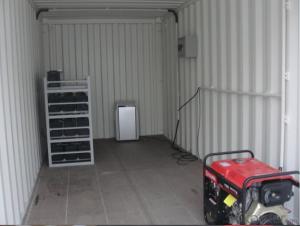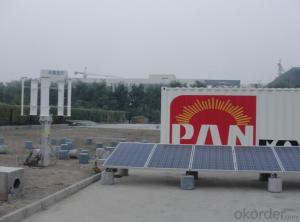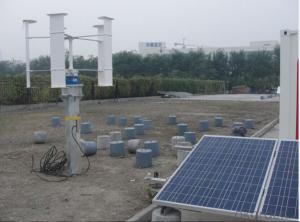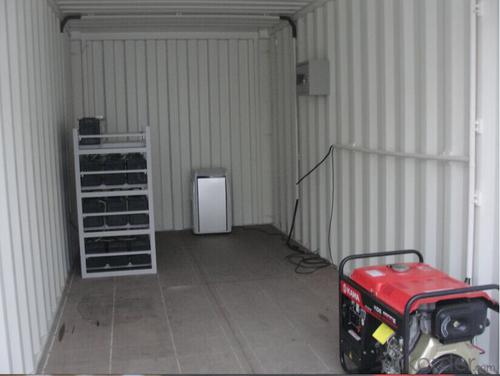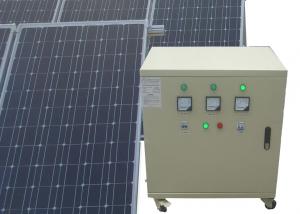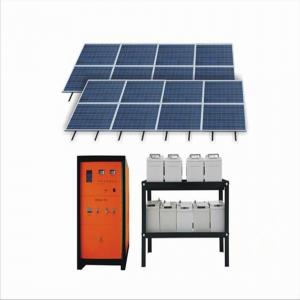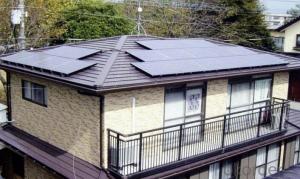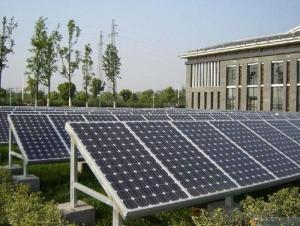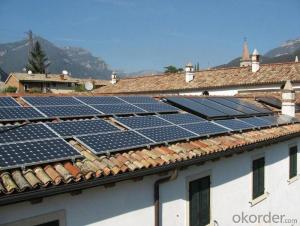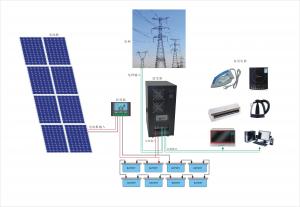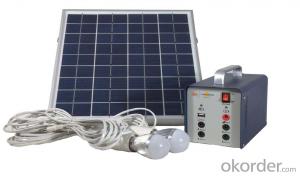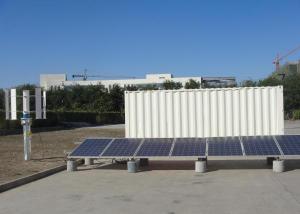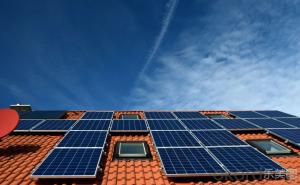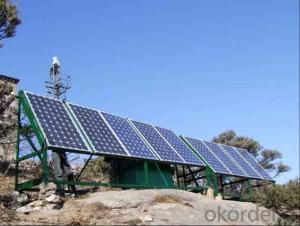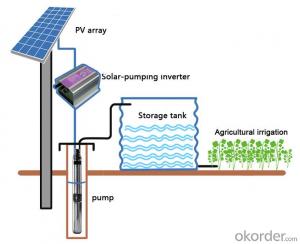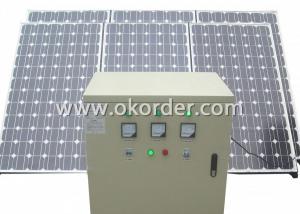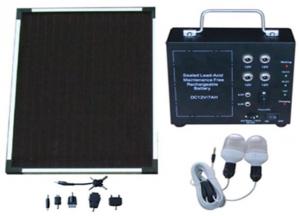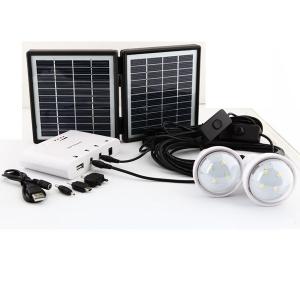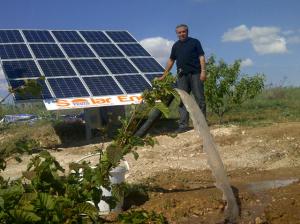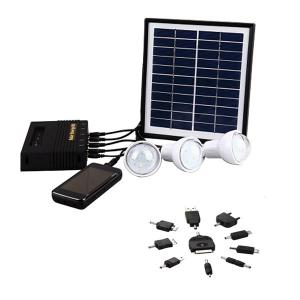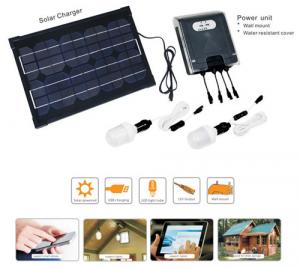Active Solar Energy Systems - Wind-PV(Diesel)Hybrid Power System 10kW
- Loading Port:
- Tianjin
- Payment Terms:
- TT OR LC
- Min Order Qty:
- 1 set
- Supply Capability:
- 30 set/month
OKorder Service Pledge
OKorder Financial Service
You Might Also Like
Specification List
Name | Specification | Quantity | |
1 | Containter | 20*8*8.6ft | 1 |
2 | Solar Module | 240W | 30 |
3 | Wind Generator | 500W | 2 |
4 | Battery | 12V120Ah | 20 |
5 | Controller | 120V/40A | 1 |
6 | Inverter | 6000W/AC230V | 1 |
7 | Diesel | 5000W/AC230V | 1 |
8 | Air Conditioner | 1000W | 1 |
9 | Cables | — | — |
10 | Others | — | — |
2.System Principle
3.System Advantage
Extend battery life |
Reduce the dependence of climate system |
24 hour uninterrupted power supply |
Low maintenance cost |
4.Product Specification
(A) Solar Module
Rated Power | 240W |
Vmppt | 29.4V |
Imppt | 8.17A |
Voc | 37.4V |
Isc | 8.55A |
Power Temp.Coeff(/℃) | -0.47% |
Ambient Temp | -40-85℃ |
Power Tolerance | ±3% |
NOCT | 46℃±2 |
(B) Battery
Rated Voltage | 240V | |
Rated Capacity (C10) | 120Ah | |
Weight | 35kg | |
Dimension | Lenth | 406mm |
Width | 174mm | |
Height | 209mm | |
Capacity | C120 | 150Ah |
C30 | 138Ah | |
C10 | 120Ah | |
C1 | 78Ah | |
Overcharging Protect Voltage | 14.4V/12V | |
Cut off Voltage | 10.8V/12V | |
(C) Wind Generator
Rated Power | 500W |
Rated Wind Speed | 13m/s |
Cut-in Speed | 4m/s |
Cut-out Speed | 25m/s |
Survival Wind Speed | 45m/s |
Mill Diameter | 1.36m |
Mill Height | 1.05m |
Mill Weight | 90kg |
Rated Voltage | AC 42V |
Rated Current | AC 6.9A |
Protection Level | IP54 |
(D) Controller
Solar Controller
Rated Power | 7.2KW |
MPPT | DC120V-350V |
Rated Voltage | DC 120V |
Rated Current | 60A |
Conversion Efficiency | ≥93% |
Overload Capacity | 120% output, 30mins |
Wind Generator Controller
Rated Power | 500W |
Maximum Power | 750W |
Rated Voltage | AC 42V |
E) Inverter
Rated Power | 6000W |
Rated Input Voltage | DC 120V |
Rated Input Current | DC 50A |
Rated Output Voltage | AC 230V |
Rated Frequency | 50Hz |
Rated Current | AC 26.1A |
Output Voltage Precision(V) | 230±5% |
Output Frequency Precision(Hz) | 50±0.05 |
Overload Capacity | 120%, 60S; 150%, 10S |
Inverter Efficiency | 80% |
- Q: Can solar energy systems be used for powering wastewater treatment plants?
- Yes, solar energy systems can be used for powering wastewater treatment plants. Solar panels can be installed to generate electricity, which can then be used to power the various processes and equipment involved in wastewater treatment, such as pumps, aeration systems, and disinfection units. This not only helps reduce the carbon footprint of wastewater treatment plants but also provides a sustainable and renewable source of energy for their operations.
- Q: What is the role of solar energy systems in reducing energy inequality?
- Solar energy systems play a crucial role in reducing energy inequality by providing access to affordable and sustainable energy sources for communities that are traditionally underserved or lack reliable access to electricity. One of the main advantages of solar energy systems is their scalability, which makes them suitable for both large-scale installations and small-scale community-based projects. This flexibility allows solar energy systems to be deployed in rural areas, where the grid infrastructure may be nonexistent or unreliable. By harnessing the power of the sun, these systems can provide electricity to homes, schools, and healthcare facilities, improving the quality of life for people in these communities and bridging the energy gap. Furthermore, solar energy systems can be installed on rooftops, reducing the need for additional land and minimizing the environmental impact. This is particularly important in urban areas where space is limited and traditional energy sources, such as coal or gas, may be more polluting and harmful to human health. Solar energy systems can help reduce air pollution and associated health issues, creating a cleaner and healthier environment for all. Another key aspect of solar energy systems is their potential for decentralized energy production. Instead of relying solely on large power plants located far away from communities, solar energy systems allow for distributed generation, meaning electricity can be produced and consumed locally. This decentralization empowers communities to take control of their energy production, reducing their dependence on centralized grids and often volatile energy prices. Solar energy systems also have the potential to create economic opportunities and reduce energy costs for marginalized communities. By investing in solar installations, communities can generate income through the sale of excess energy back to the grid, creating local jobs and promoting economic development. Additionally, solar energy systems can help lower energy bills for households, freeing up financial resources that can be allocated to other essential needs. In summary, solar energy systems play a critical role in reducing energy inequality by providing equitable access to affordable, sustainable, and clean energy sources. By addressing energy poverty and promoting self-sufficiency, solar energy systems contribute to a more inclusive and sustainable future for all.
- Q: What is the role of maximum power point tracking (MPPT) in solar energy systems?
- The role of maximum power point tracking (MPPT) in solar energy systems is to optimize the efficiency and output of solar panels by continuously tracking and adjusting the operating point of the panels to ensure they operate at their maximum power point. This is accomplished by dynamically adjusting the voltage and current at which the solar panels operate, maximizing the power output and improving overall system performance. MPPT technology enables solar systems to extract the maximum available power from the solar panels, resulting in increased energy production and improved return on investment.
- Q: What is the role of a solar energy system installer?
- The role of a solar energy system installer is to design, install, and maintain solar energy systems for residential, commercial, and industrial properties. They assess the site, conduct energy audits, determine the system size and components needed, and then install the solar panels, inverters, and other equipment. Additionally, they ensure proper electrical connections, perform system testing, and provide customer education on system operation and maintenance.
- Q: Can solar energy systems be used in powering community centers or social organizations?
- Absolutely, community centers or social organizations can definitely utilize solar energy systems to power their facilities. Solar energy is an eco-friendly and renewable power source that can cater to various electricity needs such as lighting, heating, and running electrical appliances. To meet the electricity requirements of their members or visitors, community centers and social organizations often consume a significant amount of energy. By installing solar panels on their rooftops or in nearby open spaces, these organizations can generate their own electricity and reduce their reliance on the traditional power grid. One of the major advantages of utilizing solar energy systems is the long-term cost savings they offer. Although the initial installation costs may be higher compared to conventional power sources, solar panels have a lifespan of 25-30 years and entail minimal maintenance. Consequently, over time, the investment made in solar energy systems can be recouped through reduced electricity bills. Additionally, solar energy systems are environmentally friendly as they produce no greenhouse gas emissions during operation. By harnessing solar power, community centers and social organizations can play a role in mitigating climate change and diminishing their carbon footprint. In areas prone to frequent power outages, solar energy systems can provide a reliable source of electricity. By incorporating battery storage systems, excess solar energy can be stored and utilized during periods of low or no sunlight, ensuring uninterrupted power supply to the community center or social organization. Furthermore, solar energy systems can serve as an educational tool for social organizations to raise awareness about renewable energy and sustainability. By showcasing the advantages and viability of solar power, these organizations can inspire community members to consider adopting clean energy solutions in their own homes and businesses. In conclusion, solar energy systems are a feasible and sustainable option for powering community centers or social organizations. They offer cost savings, environmental benefits, reliability, and educational opportunities. By embracing solar power, these organizations can set an example and contribute to a more sustainable future.
- Q: What are the different applications of solar energy systems in transportation?
- Solar energy systems can be used in transportation for various applications, including powering electric vehicles, charging stations, and providing energy for auxiliary systems such as lighting and ventilation in vehicles. Solar panels can be integrated into the design of vehicles or installed on rooftops of cars, buses, and trains to harness solar energy and reduce dependence on fossil fuels. This renewable energy source can help mitigate greenhouse gas emissions, increase energy efficiency, and promote sustainable transportation.
- Q: How do solar energy systems affect the environment?
- Solar energy systems have a positive impact on the environment as they produce clean and renewable energy, reducing greenhouse gas emissions and air pollution. They also conserve water resources and do not generate any noise pollution. Additionally, solar panels require minimal maintenance and have a long lifespan, making them a sustainable and eco-friendly energy solution.
- Q: Are there any risks of electrical shock with solar energy systems?
- Yes, there are potential risks of electrical shock associated with solar energy systems. While solar energy systems are generally considered safe, the presence of high voltages and electrical currents within these systems can pose a risk if not properly managed or handled. Some of the key risks include: 1. Installation and maintenance: During the installation and maintenance of solar panels, there is a risk of coming into contact with live electrical components. This can occur if proper safety procedures are not followed, or if individuals without proper training attempt to handle electrical connections. 2. Faulty equipment or wiring: Malfunctioning or faulty equipment, such as inverters or wiring, can increase the risk of electrical shock. Poor installation practices or inadequate maintenance can also lead to electrical faults, which may expose individuals to dangerous electrical currents. 3. Fire hazards: Although not directly related to electrical shock, faulty electrical components or wiring can increase the risk of fire in solar energy systems. Fires can further exacerbate the risk of electrical shock if individuals attempt to extinguish them without shutting down the electrical system first. To mitigate these risks, it is crucial to follow proper installation and maintenance procedures, which often include working with a licensed professional. Additionally, individuals working with solar energy systems should be trained on proper safety protocols, such as wearing appropriate personal protective equipment and ensuring electrical systems are properly grounded. It is also important to regularly inspect and maintain solar energy systems to identify and address any potential electrical hazards.
- Q: How do I maintain a solar energy system?
- To maintain a solar energy system, regular cleaning and inspection of the panels is crucial. Remove any debris or dirt that may obstruct sunlight absorption. Additionally, check the wiring and connections periodically to ensure they are secure and free from damage. Monitor the system's performance and keep track of any changes in energy production. Lastly, it is advisable to schedule professional maintenance once or twice a year to address any potential issues and optimize the system's efficiency.
- Q: Can a solar energy system be installed on a government building or facility?
- Yes, a solar energy system can be installed on a government building or facility. In fact, many governments worldwide are actively promoting the adoption of renewable energy sources, including solar power, in order to reduce their carbon footprint and achieve sustainability goals. By installing solar panels on government buildings, they can generate clean and renewable electricity, reduce dependence on non-renewable energy sources, and potentially save money on energy costs in the long run.
Send your message to us
Active Solar Energy Systems - Wind-PV(Diesel)Hybrid Power System 10kW
- Loading Port:
- Tianjin
- Payment Terms:
- TT OR LC
- Min Order Qty:
- 1 set
- Supply Capability:
- 30 set/month
OKorder Service Pledge
OKorder Financial Service
Similar products
Hot products
Hot Searches
Related keywords
